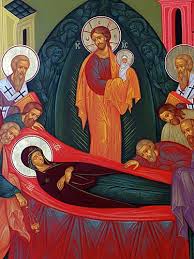 |
| Dormition of Our Lady |
ACCORDING TO LOCAL TRADITION HANDED DOWN FROM GENERATION TO GENERATION IN MURREE, MARY OF NAZARETH DIED ON THE WAY TO KASHMIR AS SHE ACCOMPANIED THOMAS ON THIS MISSIONARY ENDEAVOR.
Mary died at Murree; some believe that the name is a reference to Mary.
In the 1850's the name was still expressed as Mari.
Mari and Murree may have derived from 'Mariam' or Mary.
The Marian Shrine is believed to be where Mary was laid to rest. The site has been maintained and honored as far back as anyone can remember.
Since ancient times, Hindus had worshipped at the resting place, and Muslims paid homage on Thursdays by lighting earthen lamps filled with oil.*
The tomb itself lies east-west, oriented in Judaic custom. The resting place is known as Pindi Point.
The sepulchre is named Mai Mari de Asthan, meaning Resting Place of Mother Mary.
A document about the tomb (dated 30 July 1917), archived in file number 118 of the Muree Municipal Council tells that in times of drought, prayers and offerings at the tomb have generally succeeded in bringing rain.
Signs and wonders have been experienced by many both at the tomb, and in the vicinity.
Mary has brought such blessing to our world through the Incarnation of Jesus.
May we honor her life and her gentleness in caring for Jesus, and bringing blessings in the Marian Shrine town.
 |
| Hindus worshipped and Muslims paid homage at the resting place |
*Dr. Ali Jan, 'Marian Shrine at Muree', 2001